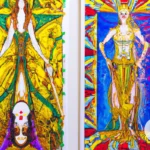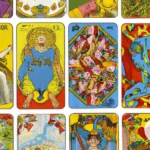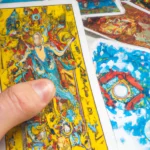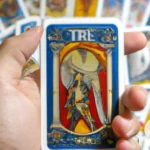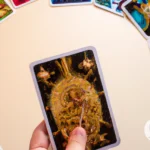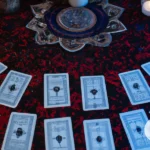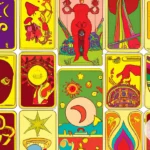The world of tarot can be both mysterious and captivating, with intricate imagery and symbolism that has been studied and explored for centuries. For those new to the world of tarot, it can be overwhelming to know where to start. Two of the most popular tarot decks are the Marseille Tarot and the Rider-Waite Tarot. While both decks share similarities, they also have distinct differences that can impact the interpretation of readings. In this article, we will explore the major differences between the two decks, including their origins, design, interpretation, and which deck may be best suited for different types of readings. By understanding the key features and nuances of each deck, readers can make an informed decision on which deck they feel most drawn to and comfortable working with.
The Origins of the Tarot
The origins of the tarot are shrouded in mystery and debate. Some believe that its roots can be traced back to ancient Egypt, while others cite its origins in the Middle East or India. However, most scholars agree that the tarot as we know it today originated in Europe during the Renaissance.
The earliest decks were hand-painted works of art, commissioned by wealthy families as a form of entertainment. It wasn’t until the 18th century that the tarot began to be used more widely for divination purposes.
One of the oldest surviving tarot decks is the Marseille Tarot, which was produced in France in the 18th century. This deck is distinguished by its simple artwork and lack of narrative imagery, but it remains one of the most popular tarot decks in use today.
The Rider-Waite Tarot, on the other hand, was created in England in the early 20th century by occultist Arthur Edward Waite and artist Pamela Colman-Smith. This deck features detailed, narrative illustrations on each card, and incorporates many symbolisms from various occult traditions.
Both the Marseille Tarot and the Rider-Waite Tarot have their own unique styles and interpretations, making them popular choices for tarot enthusiasts and practitioners alike. To learn more about the Marseille Tarot, you can check out our article on its history and origin, or our guide on how to read it for beginners. If you’re interested in the symbolism of the cards, you can check out our article on Marseille Tarot symbolism, or take a deep dive into the Major and Minor Arcana with our guides on Major Arcana and Minor Arcana. We also have resources on some of the most common spreads used with the Marseille Tarot, for more insightful readings.
Rider-Waite Tarot
When it comes to one of the most popular tarot decks in the world, the Rider-Waite Tarot often comes to mind. This classic deck, created by artist Pamela Colman Smith under the direction of mystic A.E. Waite, has remained a staple among tarot readers for over a century. Curious about the Rider-Waite deck and its unique features? Let’s dive in and explore what makes this deck stand out from the rest.
Overview of the Rider-Waite Tarot Deck
One of the most popular and well-known tarot decks is the Rider-Waite Tarot deck, named after its creators, British occultist Arthur Edward Waite and artist Pamela Colman Smith. This deck, first published in 1910, features 78 cards divided into the Major and Minor Arcana.
The Major Arcana consists of 22 cards, each depicting a unique figure or scene that represents a significant aspect of the human experience. These cards include the Fool, the Magician, the High Priestess, the Empress, the Emperor, the Hierophant, the Lovers, the Chariot, Strength, the Hermit, the Wheel of Fortune, Justice, the Hanged Man, Death, Temperance, the Devil, the Tower, the Star, the Moon, the Sun, Judgment, and the World.
The Minor Arcana consists of 56 cards divided into four suits: Wands, Cups, Swords, and Pentacles. Each suit contains 14 cards, with 10 numbered cards (Ace-10) and four court cards (Page, Knight, Queen, King).
One of the defining features of the Rider-Waite Tarot deck is its intricate illustrations, rich in symbolism and color. The cards feature a mixture of Christian and pagan imagery, drawing on a variety of sources including numerology, astrology, and alchemy. The designs of the cards are also highly detailed, making it easy to pick up on the various symbols and meanings included within each card.
The Rider-Waite Tarot deck is a classic choice for those who are new to tarot and those who have been practicing for years. Its detailed illustrations and well-established symbolism make it an accessible and informative deck for readings and personal exploration.
Key Features of the Rider-Waite Tarot Deck
The Rider-Waite Tarot is one of the most popular tarot decks in the world, known for its intricate designs and vibrant colors. Here are the key features that makes the Rider-Waite Tarot so unique:
| The imagery is highly symbolic: | The Rider-Waite Tarot deck features a wide range of symbols and illustrations that hold deep meaning and significance within the tarot tradition. Each card in the deck contains a richly detailed image that can inspire deep insights and personal revelations. |
| The deck includes 78 cards: | The Rider-Waite Tarot deck is comprised of 78 cards, which are divided into two main categories: the Major Arcana and the Minor Arcana. The Major Arcana consists of 22 cards, while the Minor Arcana consists of 56 cards divided into four suits: Wands, Cups, Swords, and Pentacles. |
| The illustrations are rich in color: | The Rider-Waite Tarot deck is known for its vibrant colors and richly detailed illustrations. The deck features a wide range of hues, from deep blues and purples to bright yellows and oranges, which add to the overall visual impact of the cards. |
| The symbolism is rooted in tradition: | The Rider-Waite Tarot deck draws heavily from the traditions of tarot and other esoteric systems, such as astrology and alchemy. The symbols and illustrations used throughout the deck represent archetypal energies and universal themes that have been used for divination and spiritual insight for centuries. |
| The deck is easy to use and read: | The Rider-Waite Tarot deck is known for its accessibility and ease of use, making it a popular choice for both beginners and experienced readers alike. The cards themselves are easy to shuffle and handle, and the symbolism is straightforward and easy to interpret. |
The Rider-Waite Tarot deck is a powerful tool for personal growth and spiritual insight. Its intricate designs and universal symbolism serve to deepen our understanding of ourselves and the world around us. Whether you are a seasoned tarot reader or a beginner just starting out, the Rider-Waite Tarot deck is an excellent choice for anyone looking to explore their innermost thoughts and emotions.
Pros and Cons of the Rider-Waite Tarot Deck
The Rider-Waite Tarot Deck is a popular choice among tarot enthusiasts for some good reasons, but like any tool, it has its pros and cons that you should consider before selecting it. Here are some of the pros and cons of the Rider-Waite Tarot Deck:
Pros:
- The Rider-Waite Tarot Deck is one of the most popular and readily available decks, so it’s easy to find and purchase.
- Its artwork is iconic, and most tarot guides and resources utilize the Rider-Waite imagery, making it easier to learn for beginners.
- The symbols and colors used on the cards are rich in meaning, and they offer a wealth of interpretation options for readers.
- The Rider-Waite Tarot Deck is great for exploring one’s inner landscape and exploring questions related to self-discovery and personal growth.
- Many tarot readers find the Rider-Waite Deck to be versatile and suitable for a variety of different tarot spreads.
Cons:
- Some tarot enthusiasts find the Rider-Waite Tarot Deck’s artwork to be too simplistic or uninspired, especially when compared to other decks.
- The imagery and symbolism of the Rider-Waite Deck can be overwhelming for some beginners, who may find it challenging to interpret the scenes portrayed on the cards.
- The Rider-Waite Deck may not be as suitable for exploring complex issues related to work, finances, or relationships.
- The Rider-Waite Tarot Deck can be restrictive for experienced readers who prefer more freedom in their interpretation style.
- Some tarot readers may find that the Rider-Waite Tarot Deck lacks diversity in its representation of people, and the deck may feel exclusive or unwelcoming to some individuals.
When it comes to choosing a tarot deck, it’s essential to weigh the pros and cons carefully, so you can select a deck that speaks to your unique needs and preferences. While the Rider-Waite Tarot Deck has its merits, it may not be the right choice for everyone.
Who Should Choose the Rider-Waite Tarot Deck?
If you are a beginner or someone who prefers straightforward symbolism, the Rider-Waite Tarot Deck may be the best choice for you. This deck is ideal for individuals who want to learn traditional tarot readings and understand the symbolism easily. The Rider-Waite Tarot Deck is also suitable for those who are interested in exploring the various meanings of each card.
Here is an html table highlighting who the Rider-Waite Tarot Deck is best for:
| Who is it for? | Why? |
|---|---|
| Beginners | The symbolism is straightforward and easy to understand, making it great for beginners who are new to tarot. |
| Traditionalists | The Rider-Waite Tarot Deck follows traditional tarot reading with well-known designs, making it perfect for traditionalists who want to explore traditional readings. |
| Those Who Enjoy Symbolism | The deck offers a variety of symbols and meanings in each card, making it an ideal choice for individuals who like to delve deeper into the symbolism of the tarot. |
The Rider-Waite Tarot Deck is a classic, traditional deck that’s easy to understand and perfect for beginners, traditionalists, and those who enjoy symbolism. However, it might not be the best fit for individuals who prefer a more modern interpretation of the tarot or want to explore different perspectives.
Marseille Tarot
The Marseille Tarot is a powerful divination tool that has been used for centuries. Its origins are shrouded in mystery, with some claiming that it was developed in ancient Egypt, while others believe it originated in medieval Italy. Regardless of its origins, the Marseille Tarot has stood the test of time and continues to be one of the most popular and respected tarot decks in the world today. Its stark and straightforward design offers a unique perspective on the world of divination, making it a favorite among many tarot readers. Let’s take a closer look at the Marseille Tarot, its key features, pros and cons, and who should choose this powerful and ancient tarot deck.
Overview of the Marseille Tarot Deck
The Marseille Tarot deck is one of the oldest and most influential Tarot decks available today. Its origins trace back to the early 18th century, where it was first created in Marseille, France. This deck consists of 78 cards, with 56 minor arcana cards and 22 major arcana cards. Unlike other decks, the Marseille Tarot deck is known for its simplicity and straightforward nature, making it a popular choice among traditionalists.
Structure and Design: The Marseille Tarot deck features the classic Tarot card structure, with 22 major arcana cards and 56 minor arcana cards. The major arcana cards are numbered from 0 to 21, each card representing a different archetype or symbolic figure. The minor arcana cards are split into four suits, with each suit representing a different element – Cups for Water, Swords for Air, Pentacles for Earth, and Wands for Fire. The minor arcana cards are numbered from Ace to 10 and have four court cards each – Page, Knight, Queen, and King.
Artwork and Imagery: The Marseille Tarot deck is known for its simple yet striking artwork. The cards feature basic line drawings and bold colors, with no intricate details or shading. The imagery used in the Marseille Tarot deck is mostly symbolic, representing universal themes and archetypes.
Card Interpretation: The Marseille Tarot deck is often referred to as the “original” or “pure” form of Tarot, as its straightforward nature allows for a more direct interpretation of the cards. The Marseille Tarot deck places less emphasis on imagery and more on the symbolism of the cards. As a result, the cards can be interpreted in a variety of ways, making it a popular choice among seasoned Tarot readers.
Popularity: The Marseille Tarot deck is a popular choice among traditionalists and those who prefer a more simplistic approach to Tarot. Its roots in Marseille, France, give it a strong cultural significance, making it a go-to deck for those interested in French history and culture. While not as widely known as some other Tarot decks, the Marseille Tarot deck has a loyal following and continues to be a popular choice among Tarot enthusiasts.
The Marseille Tarot deck is a classic and influential Tarot deck known for its simplicity, striking artwork, and direct interpretation. Its straightforward nature and strong cultural significance make it a popular choice among traditionalists and those interested in French history and culture.
Key Features of the Marseille Tarot Deck
The Marseille Tarot Deck, known for its rich history and strong occult roots, has been in existence for centuries. Here are the key features of this unique tarot deck:
| The Cards: | The Marseille Tarot Deck consists of 78 cards, including the Major Arcana and Minor Arcana. |
| The Style: | This deck is characterized by its simple and stark imagery, with only primary colors and minimalistic design in the illustrations. |
| The Symbolism: | The Marseille Tarot Deck is heavily steeped in symbolism, with each card conveying a multitude of meanings and interpretations. |
| The History: | Originating in France during the 15th century, the Marseille Tarot Deck is one of the oldest and most traditional tarot decks still in use today. |
| The Use: | The Marseille Tarot Deck is widely used in Europe for divination, but also for meditation, magical and ritual work. |
| The Energy: | This deck is known for its intense energy and is said to have a raw, primal power that can be felt when using the cards. |
The Marseille Tarot Deck is an excellent choice for those looking for a traditional tarot experience with potent symbolism and a rich history. The simplicity of the imagery encourages intuitive readings, making it an excellent tool for developing psychic abilities and intuition.
Pros and Cons of the Marseille Tarot Deck
The Marseille Tarot deck is an ancient deck that has been used for centuries. It has its own unique style and is known for its simplicity and straightforwardness. However, like any other tarot deck, it has some pros and cons that you should consider before choosing it for your readings. Let’s take a look at some of these pros and cons in more detail:
| Pros | Cons |
|---|---|
| Symbolism: The Marseille Tarot is rich in symbolism that is easy to interpret, making it easier to read for beginners as well as seasoned readers. | Limited Variation: Because the Marseille Tarot is an old and traditional deck, it has limited variation in terms of card design and interpretation, making it less versatile than other decks. |
| Straightforward: The Marseille Tarot is known for its no-nonsense, direct approach to readings, which can be particularly helpful for getting to the heart of the matter in a short amount of time. | Less Imagery: Unlike other tarot decks, the Marseille Tarot has less intricate and detailed imagery on its cards, which can make it harder to connect the cards to the situation or question being asked. |
| Historical Significance: The Marseille Tarot has a rich history and has been used for centuries, giving it a sense of tradition and authenticity that can add to the power and accuracy of readings. | Minimal Instruction: The Marseille Tarot deck comes with minimal instruction, which can make it difficult for beginners to learn how to use the deck effectively. |
Whether or not the Marseille Tarot deck is the right choice for you will depend on your personal preferences and needs. If you’re looking for a deck that is straightforward and rich in symbolism, the Marseille Tarot may be the way to go. However, if you’re looking for a deck with more variation and detailed imagery, you may want to consider another deck.
Who Should Choose the Marseille Tarot Deck?
If you are a Tarot reader who prefers a more traditional approach to divination, the Marseille Tarot Deck may be the right choice for you. This deck has a rich history and is steeped in symbolism that dates back to the 16th century.
Here are some characteristics of the Marseille Tarot Deck that may make it the ideal choice for certain readers:
| Pros | Cons |
|---|---|
| Simple and straightforward design that emphasizes the essential meanings of each card. | The lack of intricate artwork can be less visually engaging for some readers. |
| History and tradition behind the deck can provide a sense of connection to the origins of Tarot. | May not appeal to those who prefer modern or innovative approaches to Tarot. |
| Clear and direct symbolism can make interpretations easier for beginners to understand and interpret. | May not offer as much creative freedom for readers who prefer to use their own intuitive insights and interpretations. |
The Marseille Tarot Deck can be an excellent choice for those who value simplicity, tradition, and clear symbolism. It’s ideal for Tarot readers who want to focus on the heart of the Tarot and the essential meanings behind each card. While it may not have the same level of artistic flair or innovative approaches to interpretation as some other decks, it is a solid choice for those who want to explore the history and traditions of Tarot.
Comparison of Marseille Tarot and Rider-Waite Tarot Decks
When it comes to choosing a
Subscribe to Our Newsletter
Sign up to receive the latest news and updates.
Major Differences in the Card Design
When it comes to the card design of the Marseille and Rider-Waite tarot decks, there are several major differences that set them apart. One of the most notable differences is the presentation of the cards themselves. While the Marseille deck is relatively simple in its design, the Rider-Waite deck features much more intricate and detailed illustrations that incorporate rich symbolism and intricate detailing.
Another significant difference between the two decks is their color schemes. The Marseille deck uses a limited color palette of red, blue, green, and yellow, while the Rider-Waite deck features a wider range of colors, including purple, orange, and pink. This makes the Rider-Waite deck more visually striking and eye-catching, but it also means that the colors may detract from the overall meaning of the cards.
In terms of the actual imagery featured on each card, the two decks also diverge significantly. The Marseille deck features straightforward depictions of the tarot archetypes, with simple line drawings and few embellishments. The Rider-Waite deck, on the other hand, includes a wide range of additional symbols and details, making the cards much more complex and nuanced.
Finally, while both decks feature cards that are numbered and labeled with descriptive titles, the Rider-Waite deck goes a step further by including subtle visual cues that help to convey the meaning of each card. For example, the Ace of Cups in the Rider-Waite deck features a hand emerging from a cloud and holding a cup, symbolizing the flow of emotions and the potential for new beginnings.
While both the Marseille and Rider-Waite tarot decks are rich in symbolism and meaning, the Rider-Waite deck is generally more detailed and complex in its presentation. This can make it a more challenging deck to work with for beginners, but it also makes it a more rewarding deck for those who are willing to invest the time and effort into understanding its intricacies.
Differences in Card Interpretation
One of the major differences between the Marseille Tarot and the Rider-Waite Tarot decks is their interpretation of the cards. While both decks follow the same basic structure of the tarot, they have their own unique interpretations.
Rider-Waite Tarot Card Interpretation:
- The Rider-Waite Tarot focuses heavily on symbolism and imagery to convey each card’s meaning
- The cards often contain detailed illustrations with multiple layers of meaning, which can make them more complex to interpret
- The Minor Arcana cards are seen as less important than the Major Arcana and are often interpreted as representing everyday events and experiences
- The Rider-Waite Tarot encourages introspection and self-reflection, as each card invites the reader to ponder their own experiences and emotions.
Marseille Tarot Card Interpretation:
- The Marseille Tarot emphasizes traditional interpretations of the cards, focusing on the core meanings of each card
- Unlike the Rider-Waite Tarot, the Marseille Tarot does not rely as heavily on symbolism or imagery to convey its meanings
- The Minor Arcana are given equal importance to the Major Arcana, and both are interpreted as representing significant life events and experiences
- The Marseille Tarot places more emphasis on the layout of the cards in a spread, with each position having a specific meaning related to the overall reading.
It is important to note that there is no right or wrong interpretation of the cards, and ultimately, it is up to the reader to decide which deck and interpretation style resonates with them the most.
Differences in the Tarot Spreads Best Suited for Each Deck
Each Tarot deck has its own unique characteristics that make it more suitable for certain types of Tarot spreads. Let’s take a look at some of the differences in the Tarot spreads best suited for each deck.
Rider-Waite Tarot Deck: The Rider-Waite Tarot Deck is ideal for spreads that require a lot of detail and nuance. The intricate images on the cards lend themselves to in-depth readings that require a deep understanding of the symbolism on each card. Additionally, the Rider-Waite Tarot is great for spreads that involve exploring the querent’s past, present, and future in detail. The Celtic Cross is a popular spread for the Rider-Waite Tarot Deck, as it allows for a deep exploration of the querent’s situation.
Marseille Tarot Deck: The Marseille Tarot Deck, on the other hand, is better suited for more straightforward spreads. This deck is known for its bold and simple designs, which make it easy to read quickly and accurately. The Marseille Tarot is great for spreads that focus on the present moment or provide a snapshot of the querent’s current situation. It’s also a great choice for spreads that require a yes-or-no answer, or for spreads that focus on specific aspects of the querent’s life such as love, career, or health. The Three-Card Spread is a popular spread for the Marseille Tarot Deck, as it allows for a quick and simple reading that can provide insight into the querent’s situation.
Comparison: When it comes to choosing a Tarot deck for specific spreads, it’s important to consider your own personal preferences and the type of reading you want to do. If you’re interested in exploring the nuances of a situation and providing detailed insights, the Rider-Waite Tarot might be the better choice. However, if you’re looking for a more straightforward and practical reading, the Marseille Tarot might be the way to go. Ultimately, the best deck for you is the one that resonates with you the most and that allows you to read with confidence and clarity.
To summarize, the differences in the Tarot spreads best suited for each deck are:
| Rider-Waite Tarot Deck | Marseille Tarot Deck |
|---|---|
| Spreads that require a lot of detail and nuance | More straightforward spreads |
| Spreads that involve exploring the querent’s past, present, and future in detail | Spreads that focus on the present moment or provide a snapshot of the querent’s current situation |
| Celtic Cross and other in-depth spreads | Three-Card Spread and other simple spreads |
Which Deck is Right for You?
Choosing a tarot deck can be a daunting task, especially if you are new to tarot. The Rider-Waite Tarot and the Marseille Tarot are two of the most popular decks, and each has its own unique qualities. In order to help you decide which deck is right for you, let’s compare the two decks side by side:
| Deck | Pros | Cons | Who should choose this deck? |
| — | — | — | — |
| Rider-Waite | – More detail in imagery
– Familiar to many people
– Easy to find resources for learning | – May not resonate with everyone
– Some imagery can be confusing
– Some people find it too “beginner” | – Beginners who prefer detailed imagery
– Those who resonate with its symbolism
– Those who want many resources for learning |
| Marseille | – Simple, straightforward imagery
– More emphasis on numerology and symbolism
– More “pure” tarot deck | – Lack of detailed imagery may not appeal to some
– Less commonly used and harder to find learning resources | – Experienced readers who prefer numerology and symbolism
– Those who want a “pure” tarot experience |
When it comes down to it, the choice between the Rider-Waite Tarot and the Marseille Tarot ultimately depends on personal preference. If you prefer more detailed imagery and want easy access to learning resources, the Rider-Waite Tarot might be the right choice for you. However, if you prefer simple yet symbolic imagery and want a more “pure” tarot experience, the Marseille Tarot might be a better fit. Ultimately, the best way to choose a tarot deck is to look at different options and see which one speaks to you the most.
Conclusion
In conclusion, both the Marseille Tarot and Rider-Waite Tarot decks have their own unique qualities and are popular among tarot readers.
Ultimately, the choice of which deck to use depends on personal preferences and the specific needs of the reading.
While the Rider-Waite Tarot deck is known for its intricate symbolism and detailed illustrations, the Marseille Tarot deck is simpler in design but still has a rich history and tradition.
Those who prefer a more traditional approach to tarot reading and a deck with a deeper historical significance may prefer the Marseille Tarot deck. On the other hand, those who enjoy delving into symbolism and want a more modern interpretation of the tarot may gravitate towards the Rider-Waite Tarot deck.
However, it’s important to remember that both decks can be used effectively and accurately by skilled readers. It’s also worth considering that there are many other tarot decks available, each with their own unique characteristics and themes.
Ultimately, the most important factor in choosing a tarot deck is finding one that resonates with the reader and allows for a strong connection to intuition and the spiritual realm. With practice and dedication, both the Marseille Tarot and Rider-Waite Tarot decks can provide valuable insights and guidance for those seeking clarity and direction in their lives.
Frequently Asked Questions
FAQs
1. Can I use both the Marseille and Rider-Waite Tarot decks for readings?
Yes, you can use both decks for readings. However, their interpretations and spreads are different, so it’s important to choose the deck that you feel most comfortable with for each reading.
2. Is one deck better than the other for beginners?
It depends on the individual. Some beginners may prefer the simplicity of the Marseille deck while others may find the imagery of the Rider-Waite deck more helpful.
3. Are there any specific types of readings that only work with one deck?
No, both decks can be used for any type of reading. However, some spreads may work better with one deck over the other.
4. Does the Marseille deck have different meanings for the cards than the Rider-Waite deck?
Yes, there are differences in the meanings of some of the cards between the two decks. It’s important to familiarize yourself with the meanings of each deck if you plan on using both.
5. Do the differences in artwork affect the accuracy of a reading?
No, the artwork doesn’t affect the accuracy of the reading. It’s the reader’s interpretation of the cards that determines the accuracy.
6. Can I mix cards from both decks in one reading?
Technically, you can mix cards from both decks, but it’s not recommended as the meanings and interpretations may not flow together cohesively.
7. Is one deck more popular than the other?
The Rider-Waite deck is more well-known and widely used than the Marseille deck.
8. Are there any cultural differences in the symbolism used in each deck?
Yes, the Rider-Waite deck incorporates more Christian symbolism than the Marseille deck which has stronger ties to French culture and history.
9. Is one deck better for certain types of questions or situations?
Both decks can be used for any type of question or situation, but some readers may feel that one deck works better for specific situations or questions.
10. Can I use the Marseille or Rider-Waite deck for self-readings?
Yes, both decks can be used for self-readings. It’s important to trust your intuition and interpretation of the cards when reading for yourself.



